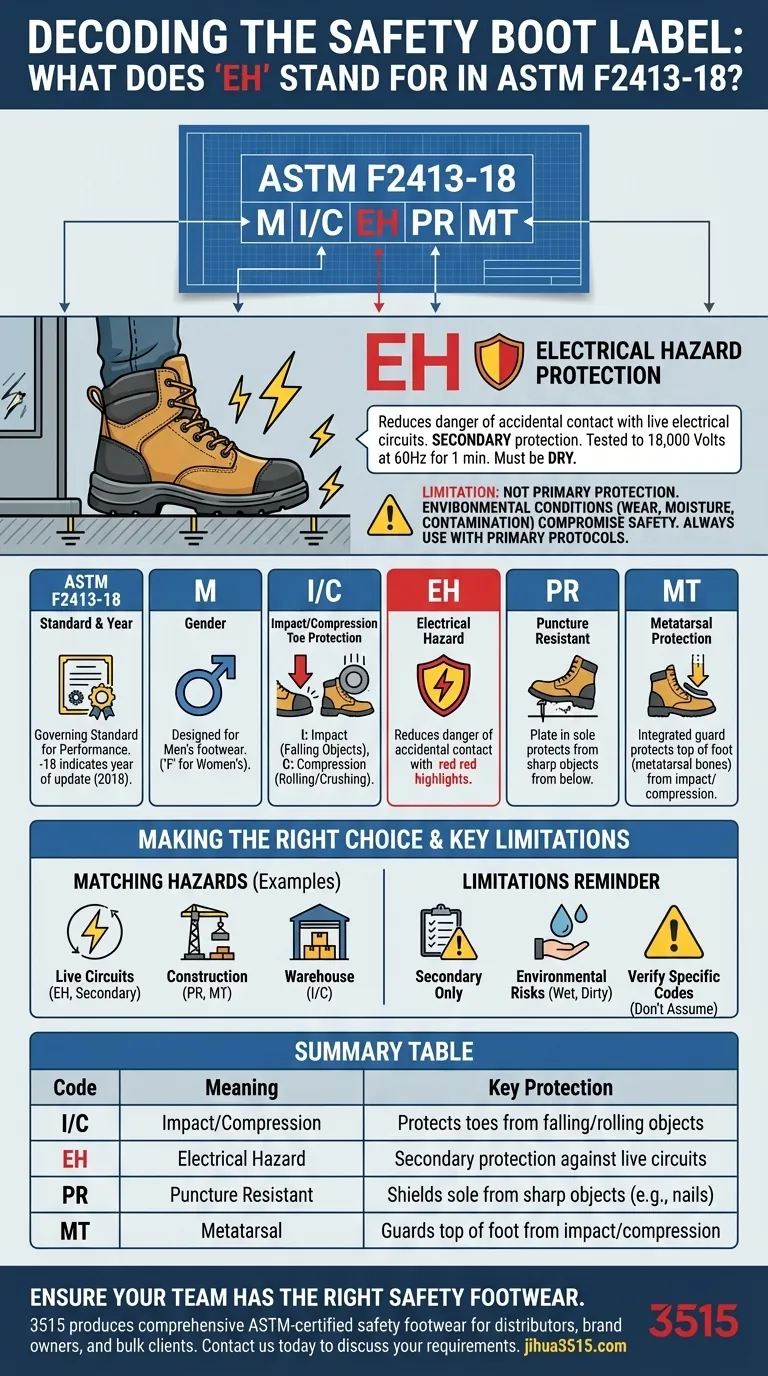In short, 'EH' stands for Electrical Hazard. This code on a safety boot certifies that the footwear is designed to reduce the danger of accidental contact with live electrical circuits. It is considered a secondary source of protection in work environments where this specific risk is present.
Safety boot labels like ASTM F2413-18 are not just codes; they are a blueprint of the specific protections a boot offers. Understanding this blueprint is critical for ensuring your personal protective equipment (PPE) actually matches the hazards of your job.

Decoding the Full ASTM F2413-18 Label
The string of letters and numbers on a safety footwear tag can seem cryptic, but each part has a precise and important meaning. Let's break down the example ASTM F2413-18 M/I/C EH PR MT piece by piece.
The Standard Itself: ASTM F2413-18
This first part identifies the governing standard. ASTM International (formerly American Society for Testing and Materials) sets the performance requirements for safety footwear. The number -18 indicates the year the standard was last updated, in this case, 2018.
Foundational Toe Protection: I/C
This is the most common feature of safety footwear. The codes represent two distinct tests for the protective toe cap.
- 'I' stands for Impact. The boot meets the standard for safety-toe protection against falling objects.
- 'C' stands for Compression. The boot meets the standard for safety-toe protection against rolling objects or crushing forces.
Gender Specification: M
This simply indicates the boot is designed and sized for Men's footwear. You would see an 'F' for footwear meeting the women's standard.
Electrical Hazard Protection: EH
This is the specific protection you asked about. Footwear marked with EH has been tested for its ability to withstand the application of 18,000 volts at 60 Hz for one minute with no current flow or leakage current in excess of 1.0 milliampere under dry conditions.
Additional Protections: PR and MT
Beyond the toe and electrical resistance, boots can offer other critical protections based on the work environment.
- 'PR' means Puncture Resistant. These boots have a puncture-resistant plate built into the sole to protect the foot from sharp objects from below, like nails or scrap metal.
- 'MT' signifies Metatarsal protection. This indicates an integrated guard that protects the top of the foot (the metatarsal bones) from impact and compression, typically from falling or dropped objects.
Understanding the Limitations
Choosing the right boot isn't just about matching codes to a job description; it's about understanding what the ratings don't cover.
EH is Secondary Protection
EH-rated footwear is intended as a secondary source of protection. It should never be the primary method of protection from electric shock. Proper workplace procedures like lockout/tagout are the primary defense.
Environmental Conditions Matter
The protective properties of EH boots can be severely compromised by environmental factors. Excessive wear, moisture, or contamination with conductive materials (like metal shavings) can negate the boot's insulating capabilities. The soles must be kept clean and dry to remain effective.
Not All Ratings are Included
Never assume a safety boot has a protection it isn't labeled for. A boot with an I/C rating for the safety toe does not automatically have EH or PR protection. You must verify that the specific codes you need are present on the boot's label.
Making the Right Choice for Your Goal
Use the ASTM label as a checklist to ensure your footwear aligns with the specific hazards you face.
- If your primary focus is working near live circuits: EH-rated footwear is a mandatory secondary defense, but always use it with primary electrical safety protocols.
- If your primary focus is construction or demolition: Puncture Resistance (PR) and Metatarsal (MT) ratings are critical to protect against nails and falling debris.
- If your primary focus is warehouse or logistics work: Impact (I) and Compression (C) ratings are the essential baseline for protection against dropped items and rolling equipment.
By learning to read these codes, you empower yourself to make an informed decision that ensures your safety on the job.
Summary Table:
| ASTM F2413-18 Code | Meaning | Key Protection |
|---|---|---|
| I/C | Impact/Compression | Protects toes from falling/rolling objects |
| EH | Electrical Hazard | Secondary protection against live circuits |
| PR | Puncture Resistant | Shields sole from sharp objects (e.g., nails) |
| MT | Metatarsal | Guards top of foot from impact/compression |
Ensure Your Team Has the Right Safety Footwear
Decoding ASTM labels is the first step; sourcing reliable, certified boots is the next. As a large-scale manufacturer, 3515 produces a comprehensive range of ASTM-certified safety footwear for distributors, brand owners, and bulk clients. Our production capabilities encompass all types of safety shoes and boots, ensuring your workforce is equipped with PPE that matches their specific hazards.
Let us help you protect your team. Contact us today to discuss your safety footwear requirements and benefit from our manufacturing expertise.
Visual Guide

Related Products
- Safety Footwear Wholesale Manufacturer for Custom OEM/ODM Production
- Premium Flame-Retardant Waterproof Safety Boots and Shoes
- Custom Wholesale Leather Safety Boots Direct Factory Manufacturing
- Premium Suede Sport Safety Shoes for Wholesale & Bulk Orders
- Customizable Anti-Smash Safety Boots for Wholesale & Private Label Manufacturing
People Also Ask
- What are OSHA approved shoes? Understanding the Correct Standards for Workplace Safety
- How long can you wear safety boots? The Lifespan is Determined by Wear, Not Time
- Do snake bite boots work? Your Ultimate Guide to Effective Snake Bite Protection
- How do safety shoes contribute to cost savings for companies? A Strategic Investment in Risk and Cost Management
- Is it normal to wear shoes in the house? A Guide to Hygiene, Comfort & Culture



















